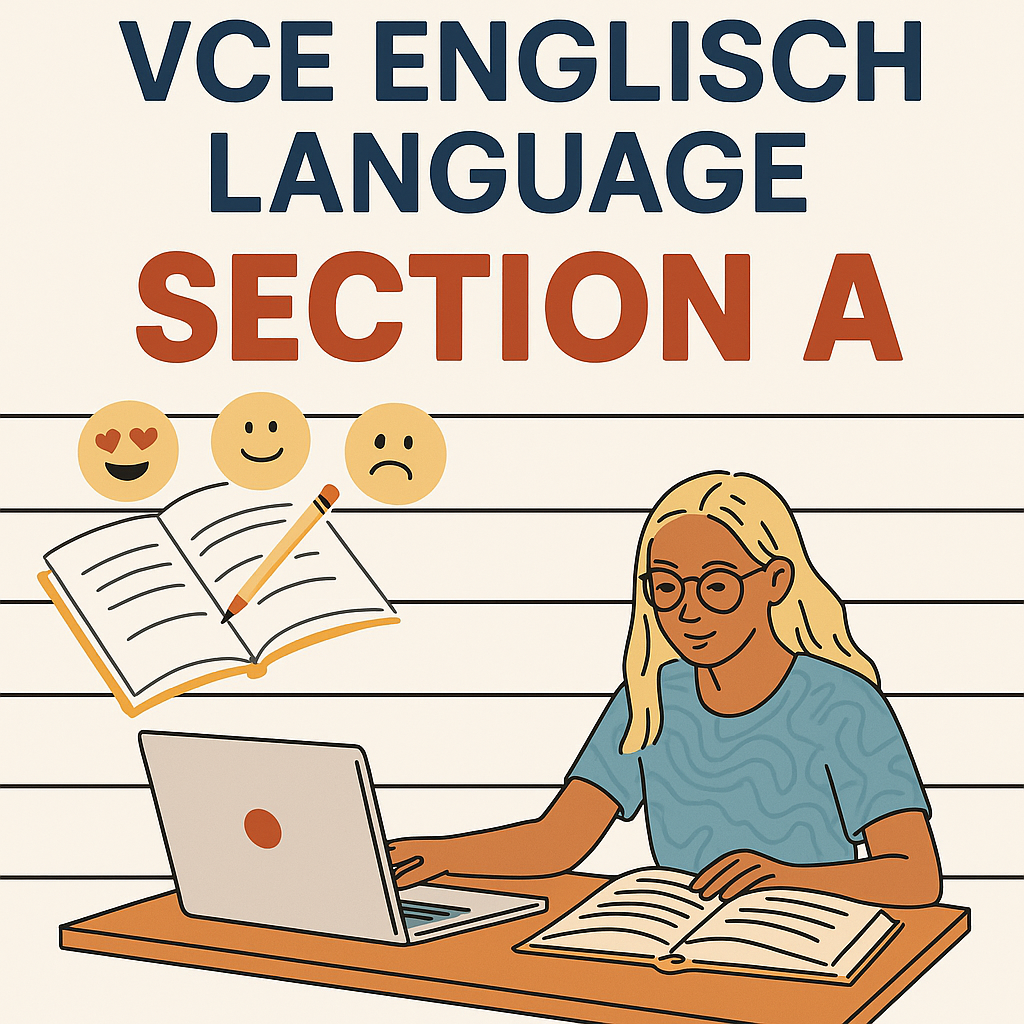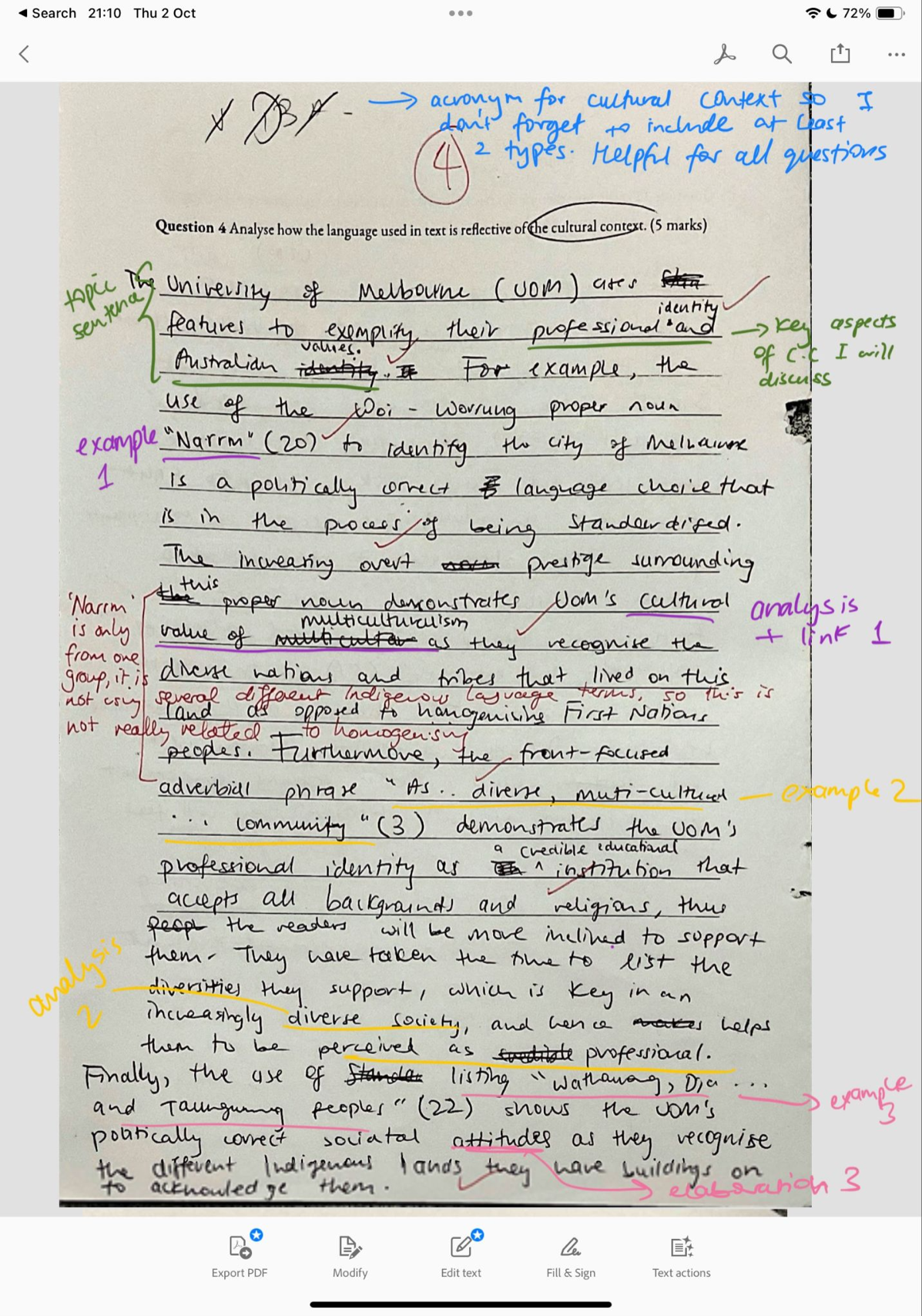
Hi everyone, my name is Poorva, and I graduated from Mac.Rob in 2024, scoring a raw 46 in VCE English Language 3/4. Today I’ll be providing a step-by-step guide on how to prepare for Section A of the VCE English Language 3/4 exam (Short Answer Questions), given that it’s just 4 weeks away!
If you are interested in a more holistic guide to approaching exam prep, check out my recent write-up: How do I prepare for the VCE English Language exam (Step-by-Step Guide)?
As a VCE English Language tutor in Melbourne, I’ve worked with many students through different VCE English Language programs, and I’ve found that mastering Section A comes down to time management, structured responses, and consistent self-marking.
1. Give yourself 6–7 minutes of reading time
When you do full practice exams, read the SAQ text last so you retain it the most, and then complete Section A first. During reading time:
- Read questions first and focus on sociolinguistic concepts (1 min)
- First reading of text – read text and get big ideas (2 min)
- Second reading – read and scan features for any questions with line number range → easy marks (2 min)
- Attempt holistic questions in your head (if time allows, 1 min)
This method helps you stay focused on key VCE English Language features and prepare your examples efficiently.
2. Start writing and annotate effectively
There’s no need for highlighters (I prefer to circle/underline using my pen), but do whatever works for you. Think about annotating your text for line number ranges, metalanguage, and key analytical ideas you may have thought of during reading time that you want to get down straight away.
This is exactly what I tell my VCE English Language tutoring students — clear annotation saves time and ensures your analysis stays relevant to the question.
3. Aim to complete Section A in 20–25 minutes maximum
This ensures you have enough time to finish Section B and C within the allotted 2 hours. If you are struggling, aim for low-hanging fruit. Remember, it’s easier to get the first 3 marks of a 5-mark question than it is to get the last 2.
If you are short on time, forego writing that 3rd example and instead finish off a 2-mark question because you may end up getting 2/2 for it.
Time efficiency is a skill developed through practice — something all strong VCE English Language students learn in well-structured VCE English Language programs.
4. Structure your responses correctly
When it comes to your responses, always be sure to fill up all the provided lines. You need to structure your responses correctly, following the Quote–Comment–Link structure and having enough examples based on how many marks the question is worth.
Let me walk through Step 4 in a bit more detail.
There are two different types of SAQs: those with 1–4 marks and those with 5–6 marks.
- For the former type, you should have 1 example for every two marks, rounding up if the marks allocated are odd.
- 5–6 markers are marked more holistically, so although you will have 3–4 examples in your response, you should also include a topic sentence and treat it like an Analytical Commentary (Section B) paragraph.
Here is a relatively high-scoring response for a 5-mark question about cultural context. Notice how every example links to a different aspect of cultural context. I also introduce the quote before my analysis because it flows better that way; students often introduce their ‘link’ first, which makes their response seem unstructured.
This kind of clear analytical approach is something every VCE English Language tutor will encourage to help you strengthen your writing coherence.
5. Mark your SAQs using the Answer Guide on the same day
Finally, and this is the most important bit — you need to be marking your SAQ using the Answer Guide on the same day!
It would be even better if you and a peer swap responses and mark each other’s so there is no personal bias and that way you can also see what ideas your mates have.
You should also be logging your mistakes and remembering high-yield features for next time (these are the features that pop up commonly for each text type) and writing learning summaries.
This reflective habit is at the core of every strong VCE English Language program, and it’s something a good VCE English Language tutor in Melbourne will reinforce regularly.
Final thoughts
Mastering Section A of the VCE English Language exam takes practice, structure, and reflection. If you focus on applying these steps, you’ll notice your short-answer accuracy and timing improve significantly.
Working with an experienced VCE English Language tutor or joining a structured VCE English Language program can provide extra feedback and ensure you’re exam-ready with strong analytical skills and time discipline.

